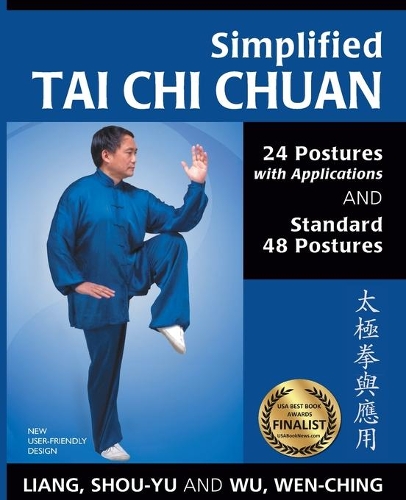
Simplified Tai Chi Chuan: 24 Postures with Applications & Standard 48 Postures
(Paperback, 2nd New edition)
Available Formats
Paperback, 2nd New edition
Published: 1st July 2014
Hardback, 2nd New edition
Published: 13th November 2024
Publishing Details
Simplified Tai Chi Chuan: 24 Postures with Applications & Standard 48 Postures
By (Author) Shou-Yu Liang
By (author) Wen-Ching Wu
YMAA Publication Center
YMAA Publication Center
1st July 2014
2nd New edition
United States
Classifications
General
Non Fiction
613.7148
Runner-up for USA Best Books Award 2015 (United States)
Physical Properties
Paperback
336
Width 184mm, Height 238mm
667g
Description
With every movement presented in 2-4 large photos along with instructions, this title includes two popular sequences: Simplified 24 Posture Sequence created in China in 1956 to popularize tai chi worldwide, and the Standard 48 Posture Sequence created in 1976 to help intermediate students experience traditional movements in a mid-length form.
Reviews
This guide successfully explains in clear language and visual imagery the basic concepts of this gentle martial art. The third edition of Simplified Tai Chi Chuan: 24 Postures with Applications and Standard 48 Postures gives detailed instruction about this health-enhancing exercise. Experienced martial arts practitioners and teachers, Shou-Yu Liang and Wen-Ching Wu write knowledgeably about two condensed forms of tai chi chuan intended for beginning and intermediate students. In 1956, the Chinese Sports Commission developed a twenty-four posture alternative to the Yang style long form to promote the practice of tai chi chuan. An expanded forty-eight movement sequence, compiled by the Chinese National Athletic Association in 1976, incorporates postures from Yang, Chen, Wu, and Sun styles. Some fast movements included in that sequence "characteristic of martial arts power emission called fajin" offer students new challenges. Both sequences emphasize the rewards that come with consistent practice. An introductory narrative reviews the history and theory behind the five principal styles of tai chi and explains the body movements, awareness of breath, and coordination of mind with internal energy that are basic to the practice. The authors write in a straightforward style that establishes the clear focus necessary for learning this ancient art. Because Chinese pinyin words and phrases used in the book may be unfamiliar to novices, Liang and Wu provide English equivalents, in parentheses, after each pinyin word. These terms include, for example, "taijiquan (tai chi chuan)," "qi (chi)," "dan tian (dan dien)," and "qigong (chi kung)." An appendix lists the names of postures in sequential order for the twenty-four and forty-eight movement forms. A glossary of Chinese words provides further clarification. According to the authors, tai chi postures evolved in imitation of animal behavior and other aspects of nature. The English translations of these names offer visual reminders to students as they learn to execute the movements. Names such as "White Crane Spreads Its Wings," "Wild Horse Parts Its Mane," and "Needle at Sea Bottom" are followed by parenthesized pinyin phrases. Photographs show a man performing each posture, with directional arrows indicating his foot and hand movements. Charts and graphs offer additional visual help and complement the book's explanatory text. Martial arts applications for the twenty-four posture form follow a similar format. In the photos, two participants wear white and gray jackets to distinguish their defensive or offensive positions. These explanations are not included for the forty-eight posture sequence. The book ends abruptly with that form's closing posture, a minor flaw in this otherwise professionally astute work. As an instructional book, Simplified Tai Chi Chuan successfully explains in clear language and visual imagery the basic concepts of this gentle martial art. Tai chi chuan is traditionally practiced in groups, often in the company of a leader or teacher. Learning these simplified forms on one's own requires considerable patience and commitment. Nevertheless, those wanting to undertake this challenge will find helpful knowledge and encouragement in the book. Others interested in learning the history and theory of this fascinating martial art will be well served. -- Margaret Cullison, This guide offers excellent instruction for those who wish to know more about this internal martial art. Foreword Reviews, October 16, 2014
Author Bio
Grandmaster Liang, Shou-Yu, is author of numerous martial art books and videos, and an internationally renowned teacher of Chinese martial arts and qigong. He is one of China's top coaches, a past judge for numerous national martial arts competitions, and head coach for the first and second Canadian National Wushu teams. Grandmaster Liang operates his martial arts institute in Vancouver British Columbia. Wen-Ching Wu is author of seven books and five videos. He is a past USA martial arts grand champion and has been teaching martial arts since 1991. Wen Ching Wu resides near East Providence, Rhode Island.
